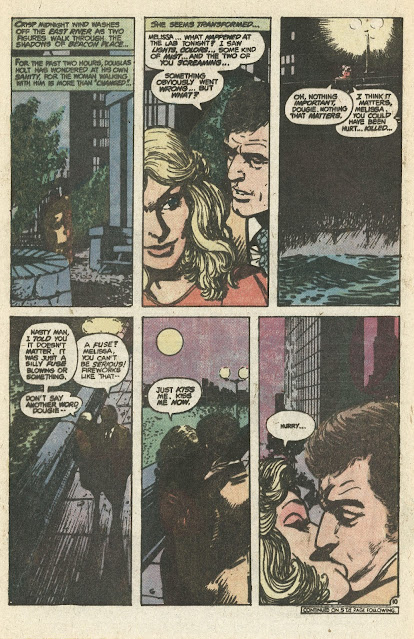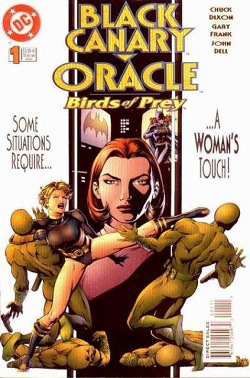I don't remember what drew my attention to DC's seventies spiritualist Madame Xanadu, but I found myself wondering how much, if at all, her introductory stories qualified her for (1) centric status, and (2) combative status. My verdict is that she satisfies my criteria for both, but oddly, the original five issues of her debut comic, DOORWAY TO NIGHTMARE, also reflect a strong influence from the Gothic subgenre that DC Comics toyed with during that decade. The Gothic, in my definition, tends to include a strong element of sexual transgression, while the more overarching category of horror fiction does not utilize sexual transgression as prominently.
I'll exclude two of these early "Madame X" stories from this summary, because I want to review them in more detail elsewhere.
DOORWAY #1-- This issue, like the one following it, uses the title of the book in place of a separate story-title, so I'll use as a title a phrase from the first page of David Micheline's script: "The Emporium of Truth." The mysterious Madame Xanadu runs a fortune telling shop in New York's East Village, and like all the later DOORWAY stories, she seems to draw to her people with romantic conflicts. Actress Cindy Barnes has been dating playwright Brad Jacobs, but she finds herself sidelined by another actress, name of Erika. Xanadu intuits through her reading of her Tarot cards that Erika is more than she seems, and the quasi-heroine displays her ambiguous powers by defeating an apparent demonic attacker.

This scene also establishes a constant motif, that upon defeating a foe, Xanadu seemingly imprisons her former foe's essence in a glass jar. Cindy then learns that Erika is actually an ancient Egyptian sorceress in modern garb, and that she plans to drain Brad of his spirit-energies. Xanadu, rather than directly combating the sorceress, encourages Cindy to break the witch's soul-pyramid, after which the sorceress perishes.

Vaulting over issue #2 for later consideration, issue #3 is the first Xanadu story to merit a title, "Blood Red Tear." Scribe Bill Kunkel and artist Ric Estrada issue a serviceable vampire story, in which an unaging bloodsucker, Victor Christianson, falls for mortal woman Margot. Xanadu does not actively oppose the vampire, but uses her Tarot skills to make Victor sacrifice himself to keep from making Margot one of the undead. Xanadu does apparently collect his soul or whatever for one of her little jars. Given the theme of sacrifice, the last name "Christianson" is probably no coincidence.

DOORWAY #4 contains the risibly titled "Six Claws of the Dragon," written by Andrews and Hopen and penciled by EC legend Johnny Craig. Two mummies from ancient Manchuria go missing from a New York museum, and for some reason police detective Abrahms finds himself seeking the shop of Madame Xanadu for information. He also meets two Asian women, and he falls in love with the younger one, Sue Lie Hau. An undead Chinese swordsman appears to take Abrahms' life, but Xanadu apparently does some hocus pocus so that, though she Xanadu appears to get knocked out a window by the assassin, somehow the swordsman ends up on the pavement. The older Asian woman is behind it all, seeking to transfer the soul of a mummy-princess into the body of Sue. At Xanadu's urging, Abrahms is able to reach Sue by the power of love, so that the evil spirit is exorcised. Xanadu adds another jar to her collection.

"Day of the Devils" in DOORWAY #5 is by Scott Edelman and Romeo Tanghal, and alone boasts no sexual transgression elements, though it's still a supernatural romance story, Handsome youth Johnny joins a vicious gang to gain acceptance, but cute girl Anne tries to talk him into leaving the gang. They both end up at Xanadu's shop, but for once, the seeress becomes pro-active. At the shop Johnny has a dream in which he becomes a literal devil and Anne wields mystic powers to stop him. When the dream ends, Johnny decides to tread the straight and narrow from then on. This time Xanadu appears to use a mystic jar to create the dream but she doesn't make any new acquisitions.
Once DOORWAY was cancelled, four inventory stories then appeared in DC's anthology magazine, THE UNEXPECTED.
UNEXPECTED #190 presents "Tapestry of Dreams" by Cary Burkett and Juan Ortiz. Young Stephen comes to Xanadu because his girl Lauren has become besotted with an older man, the mysterious Mister Hazel. Prior to Stephen's advent, though, the reader has seen Hazel visit Xanadu's emporium, making clear that he's no mystery to Xanadu. She reveals to Stephen he's truly an incubus named Azazel, and that the only way to free Lauren from his control is by entering the girl's dream-world and defeating the incubus in combat. Xanadu performs no combat herself but does lend Stephen some undefined power, and after the lovers are liberated, Mister Hazel ends up in a jelly jar.

UNEXPECTED #192 offers "Wheel of Fortune" by Bill Kelley and Romeo Tanghal. A girl named Joyce witnesses a "disco inferno" at a New York club, seeing female friend Erica disappear while dancing with the handsome but enigmatic club-owner Damon (whose band-members look like demons). After consulting with Xanadu, Joyce-- who is herself attracted to Damon-- returns to the club and sees Erica again, but the formerly young girl seems aged. Xanadu tells Joyce that a devil-cult has taken over the disco, and Joyce herself learns that the band of demons has suborned Damon. Though there's one incident in which Xanadu seems to protect Joyce from a mundane attack, she allows Joyce to have the triumph of banishing the club's evil, and this time one of the seeress' jars is comparatively crowded. I believe this is the first story in which the script calls Xanadu a "gypsy."

UNEXPECTED #194-- Andrews and Hopen return to write "Moonlight and Laughter" with art by Jess Jodloman. The story starts out with more action than usual, as a werewolf tries to exhort from Xanadu, only to be slain by the rifle of werewolf hunter Lyle Morgan. Xanadu makes a few dire predictions to Lyle, and then he goes to visit his girlfriend Mina, who's working at a comedy club (?) Mina knows all about how Lyle became a hunter after a werewolf slew his first love, and the two of them end up at Xanadu's emporium. Lyle desires vengeance on the particular shapechanger who killed his ex, and after that, a new wolf-thing shows up, almost killing Lyle until Xanadu repels the creature. Later Lyle and Mina learn of a whole cult of werewolves, and this leads to Lyle finding his quarry, though not with the usual upbeat romantic conclusion.

UNEXPECTED #195-- Finally, Denny O'Neil and Johnny Craig execute "Deadly Homecoming," in which an embittered soldier, Johnny Dallas, returns home from Vietnam, meeting his fiancee Vanessa. Johnny expresses rage at both his commanding officer and at Vanessa's father, and both of them die soon after. Vanessa visits the emporium, and Xanadu gives her a protective amulet. It turns that Johnny and his soldier-buddy Frank fell afoul of a Vietnamese war-god, who imbued Frank with mental powers, which he used to make Johnny the catspaw for his murders. Xanadu appears, shows Frank a soul jar, and that's enough for the soldier to commit suicide, so that the war-god somehow ends up in the jar.

In conclusion, like the majority of DC horror stories, most of these are mediocre at best. Though much is made of Xanadu's Tarot skills, none of the writers or artists do much with Tarot symbolism or imagery. The last inventory story happened to be executed by fan-favorites Steve Englehart and Marshall Rogers, so DC Comics decided to publish this story as a one-shot comic, MADAME XANADU, in 1981. I want to eventually giving this story more detailed attention, so aside from that story and the one in DOORWAY #2, Xanadu's debut is marked by a few scattered myth-nuggets in stories that feel a bit like a romance comic crossed with The Phantom Stranger.


















































